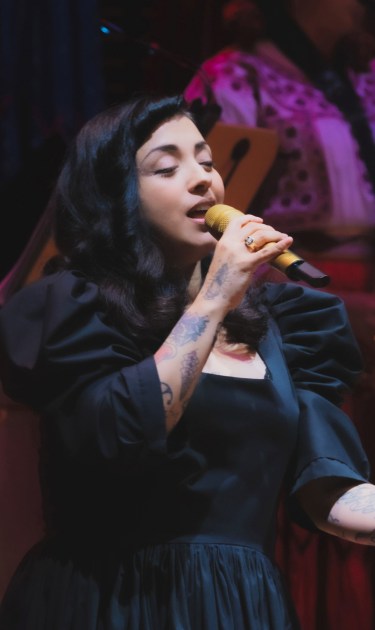An air of anticipation swept through Lincoln Center’s Wu Tsai theater in New York City on Feb. 19 as concertgoers eagerly waited to see Mon Laferte accompanied by Oaxacan group Mujeres del Viento Florido. Led by maestra Leticia Gallardo Martínez, Mujeres del Viento brought their interpretations of traditional Oaxacan music for the first time to the U.S. With a high regard for Mujeres’ artistry, the live collaboration was fueled by a fundamental ethos dedicated to the women who shaped Mon Laferte. These women come from a range of backgrounds, like the Mexican-Costa Rican roots of her inspiration Chavela Vargas, or the rich heritage of Mujeres del Viento Florido. Through her music, Mon Laferte has the ability to unite the cultural range of these women along with her own, emanating an “imagined country.” On this particular evening, the true framework behind Laferte’s career unfolded in front of the mesmerized audience.
Laferte’s ability to produce music informed by her surroundings, like her Grammy-nominated album 1940 Carmen, which took inspiration from her pregnancy experience in Los Angeles, has molded her decade-spanning career, from the folk endeavors of Seis to the joyous arrangements of La Trenza. This ability can be compared to the work of Isabel Allende, a Chilean writer whose book “Mi País Inventado,” or “My Invented Country,” serves as a reflection of her feminist values and analysis of her sentimental relationship with her motherland. Allende wrote this book while living in California, parallel to Laferte’s recent musical process. Both share an “imagined country” informed by their longing for Chile and the cherishing of their new homes.
Like Allende, Laferte divides her time in two countries—Chile and Mexico—but still carries the nostalgia of these environments through her contemplative scores. Moreover, Laferte’s cross-cultural sound creates a transformative destination empowered by storytelling surrounding social advocacy, feminism, and the future of Latine women today. As she engaged in regional Mexican ranchera, augmented by the messages of progress for Chile, audiences got to experience the magic of Mon Laferte’s very own “imagined country.” Timeless boleros, grand ballads, and a dose of salsa are all a part of Mon Laferte’s sonic architecture to unite genres across Latin America. The show facilitated a unique space that welcomed all of her influences. Her imagined destination fused the timeless ballrooms of Mexico City with songs like “El Beso” and the golden landscapes of California with “Placer Hollywood.”
Under the colorful banner splashed across the entrance, I mingled with concertgoers about the significance of this performance. One recalled the feminist message of Laferte’s concert she saw in 2019, sharing that this time it felt more magnified with the accompanied Mujeres del Viento Florido. Also in attendance was Mirian Masaquiza, a Kichwa-Salasaka from Ecuador and representative for the United Nations Permanent Forum on Indigenous Issues. Accompanied by her daughter, she could hardly contain her excitement surrounding the concert. “Not everyone makes it to Lincoln Center,” Masaquiza told Remezcla. “I hope this opens up more opportunities for indigenous music to be exposed to a diverse audience like this.”

From tubas to clarinets, the instruments of Mujeres del Viento propped across the expansive stage set the tone for a show that would embrace synergy. Maestra Martínez descended onto the stage as Mujeres del Viento joined her in a range of multi-colored skirts, engaging in a boundless introduction of brass work and percussion. The show then trickled into the opening notes of “La Trenza.” Laferte’s entrance brought on radiating applause as she sang in Spanish, “I know, a star you will be.”
Mujeres del Viento Florido united delicate harmonies with “Se Va La Vida,” Laferte’s initial collaboration with the group. She noted, “Thanks to this song, I collaborated with Mujeres. All thanks to some beers on a day out when I heard them playing.” However, the rendition of “Canción Sin Miedo” from Mexican composer Vivir Quintana propelled Laferte’s voice to a new pinnacle. Gaping with an immense force, she sang, “I’m the girl that you raised by force,” then finishing off the number with a “¡Viva Chile! ¡Viva Mexico!” Fans took this as a signal to rep their flags in the air, celebrating the symbolic hymn denouncing gender violence.
Laferte’s setlist was curated with intention. The next song embarked into the protest call of “Plata Ta Tá.” With “Se Me Va Quemar El Corazón,” Laferte took a moment to speak with the audience. “Thank you very much for fulfilling the dream of being here next to Mujeres del Viento Florido,” she said.

This marked a symbolic moment for her imagined destination; a concert in New York brought together by sounds and communities from all over Latin America. The final words of Allende’s book flooded my mind: “In closing, I want to add that the United States has treated me very well, has allowed me to be myself or whatever version of me I can think of to create.” At Lincoln Center, Laferte found herself in the same position as Allende, armed with the agency to create, shape, and manifest her distinctive vision on stage.




